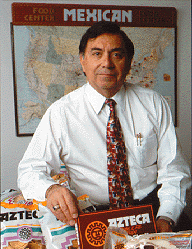
The University of Chicago Magazine
February 1997

Key Ingredients

Businessman Arthur Velasquez, MBA'67, knows a lot about recipes. He can tell you the exact mix of flour, water, and vegetable shortening needed to make close to 3 million tortillas--the average daily output of Azteca Foods, the Chicago company he founded in 1970. Azteca's total annual sales (including other products, such as salad shells and dry tortillas) now exceed $30 million, thanks largely to supermarket sales in 35 states.
Velasquez can also tell you the main ingredient of his lifelong success. "You've got to have a spark inside," he says, "that drives you to become an independent businessperson."
The spark that's made Velasquez a leader in both business and the community seems to run in the family. His father, the son of Mexican migrant workers, only finished the eighth grade but continues at age 81 to head one of Chicago's largest music-and-game-vending businesses. As a boy, Velasquez watched his father tend his business; as a talented student of science and math in grammar school and high school, he helped with the business's electronic games. Today, Velasquez's own business follows suit: Wife Joanne is Azteca's vice president, and both a daughter and a son work in the company.
Velasquez attended Notre Dame for his B.S. in electrical engineering, and he had dreams of establishing an electrical contracting outfit of his own. But first he came to the Graduate School of Business, which he credits with giving him his first opportunity to formalize his business skills. During graduate school, Velasquez worked for a large corporation; afterward, he chose to work for a small, private firm. "I never gave up a vision of [my own] company," he says.
In 1970 the vision materialized in an unlikely way. Velasquez and nine others from the Pilsen neighborhood's Azteca Lions Club pooled their savings to found Azteca Corn Products Corporation, appointing Velasquez president. In 1984, the Pillsbury Company bought Azteca, enabling the company to go national. Five years later, Velasquez and his wife assembled an investor group, acquired venture capital, and purchased Azteca back, developing it into the family business it is today.
Azteca's southwest Chicago plant currently employs 125 people. "We are very proud of our employees," says Velas-quez. "Most of them came here as very poor immigrants." He adds that the daughter of one employee won a scholarship to the U of C, where she is now a student in the College. For him, this sort of employee achievement is a high point of his business success. "We come to work as part of the [Latino] community," Velasquez notes. "It's a togetherness that makes it successful."
He believes the same holds true outside the factory walls: "I am always trying to broker, or bring together, our community, which is developing very quickly," he says. Velasquez serves on numerous corporate, educational, and philanthropic boards, and he is past national director of the Mexican-American Legal Defense and Education Fund; past president of the National Tortilla Association; and past director of the Hispanic Housing Development Corporation. As a trustee of the University of Illinois from 1974 through 1980, he was the first Latino elected to any statewide office.
His community work, he estimates, takes about a third of his time. A main focus of his volunteer efforts has been to bolster the Latino community through education and economic development. For example, at the U of C, where he also sits on the GSB's advisory council, he has helped facilitate a summer program that brings Latino high-school students to campus to hone their leadership skills.
As one of the Chicago Latino community's most active leaders, Velasquez has made a mission of encouraging success among Latinos, now the fastest-growing population in the country. That success, he believes, will come from an appropriate mix of community, work, and family. "You can't separate them," says Velasquez. And he never has.--C.M.
Within Class News:
Go to:
- INVESTIGATIONS
- CHICAGO JOURNAL
- EVENTS
- LETTERS
- CHICAGOPHILE
- Feature story, "Life Support"
- Feature story, "Brushes with perfection"
- Feature story, "Opening Chapters"
- Feature story, "Astronomical Figures"